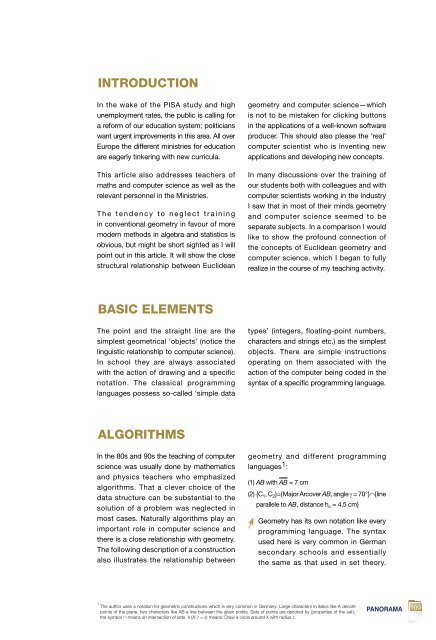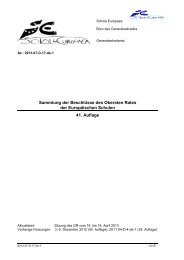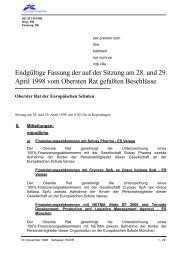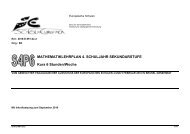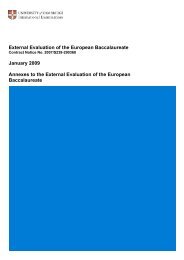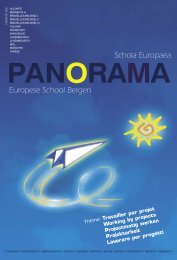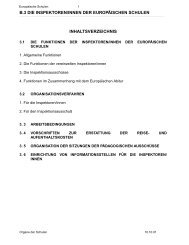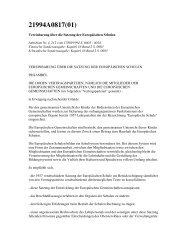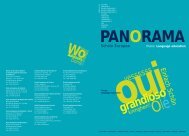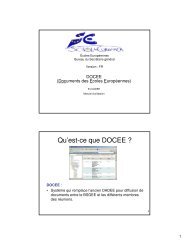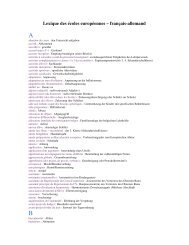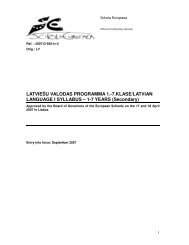Schola Europaea European School Brussels II
Schola Europaea European School Brussels II
Schola Europaea European School Brussels II
Create successful ePaper yourself
Turn your PDF publications into a flip-book with our unique Google optimized e-Paper software.
INTRODUCTION<br />
In the wake of the PISA study and high<br />
unemployment rates, the public is calling for<br />
a reform of our education system; politicians<br />
want urgent improvements in this area. All over<br />
Europe the different ministries for education<br />
are eagerly tinkering with new curricula.<br />
This article also addresses teachers of<br />
maths and computer science as well as the<br />
relevant personnel in the Ministries.<br />
T h e t e n d e n c y t o n e g l e c t t r a i n i n g<br />
in conventional geometry in favour of more<br />
modern methods in algebra and statistics is<br />
obvious, but might be short sighted as I will<br />
point out in this article. It will show the close<br />
structural relationship between Euclidean<br />
BASIC ELEMENTS<br />
The point and the straight line are the<br />
simplest geometrical ‘objects’ (notice the<br />
linguistic relationship to computer science).<br />
In school they are always associated<br />
with the action of drawing and a specific<br />
notation. The classical programming<br />
languages possess so-called ‘simple data<br />
ALGORITHMS<br />
In the 80s and 90s the teaching of computer<br />
science was usually done by mathematics<br />
and physics teachers who emphasized<br />
algorithms. That a clever choice of the<br />
data structure can be substantial to the<br />
solution of a problem was neglected in<br />
most cases. Naturally algorithms play an<br />
important role in computer science and<br />
there is a close relationship with geometry.<br />
The following description of a construction<br />
also illustrates the relationship between<br />
geometry and computer science—which<br />
is not to be mistaken for clicking buttons<br />
in the applications of a well-known software<br />
producer. This should also please the ‘real’<br />
computer scientist who is inventing new<br />
applications and developing new concepts.<br />
In many discussions over the training of<br />
our students both with colleagues and with<br />
computer scientists working in the industry<br />
I saw that in most of their minds geometry<br />
and computer science seemed to be<br />
separate subjects. In a comparison I would<br />
like to show the profound connection of<br />
the concepts of Euclidean geometry and<br />
computer science, which I began to fully<br />
realize in the course of my teaching activity.<br />
types’ (integers, floating-point numbers,<br />
characters and strings etc.) as the simplest<br />
objects. There are simple instructions<br />
operating on them associated with the<br />
action of the computer being coded in the<br />
syntax of a specific programming language.<br />
geometry and different programming<br />
languages 1 :<br />
(1) AB with AB = 7 cm<br />
(2) {C1, C2}={Major Arcover AB, angle γ = 70°}∩{line<br />
parallele to AB, distance hc = 4,5 cm}<br />
Geometry has its own notation like every<br />
programming language. The syntax<br />
used here is very common in German<br />
secondary schools and essentially<br />
the same as that used in set theory.<br />
1 The author uses a notation for geometric constructions which is very common in Germany: Large characters in italics like A denote<br />
points of the plane, two characters like AB a line between the given points. Sets of points are denoted by {properties of the set},<br />
the symbol ∩ means an intersection of sets. k (X; r = z) means: Draw a circle around X with radius z.<br />
PANORAMA 109


